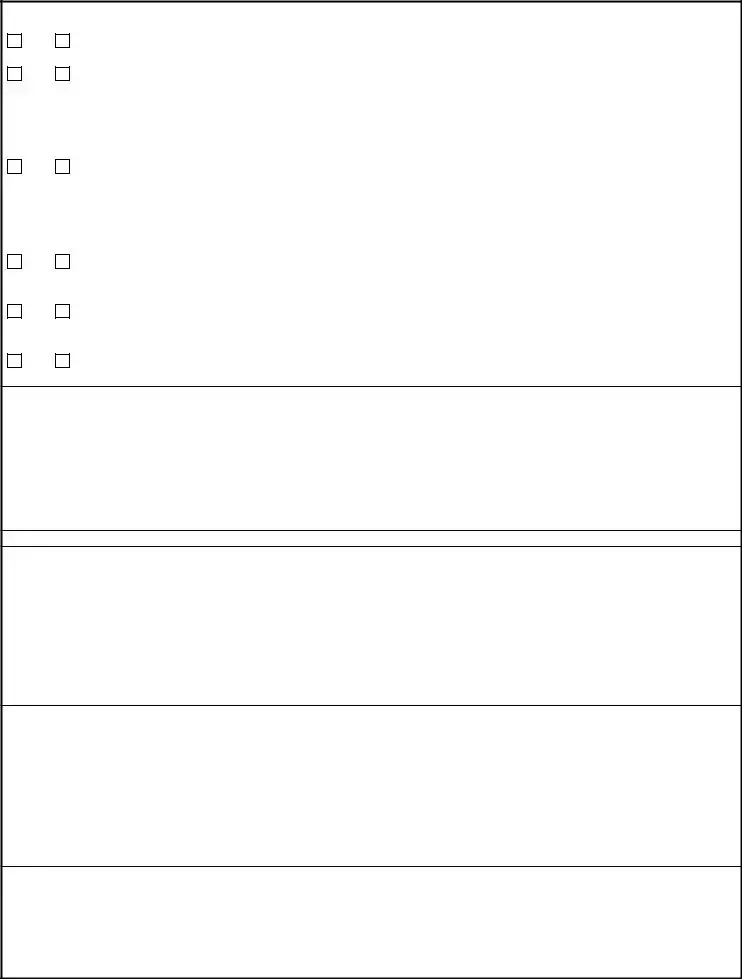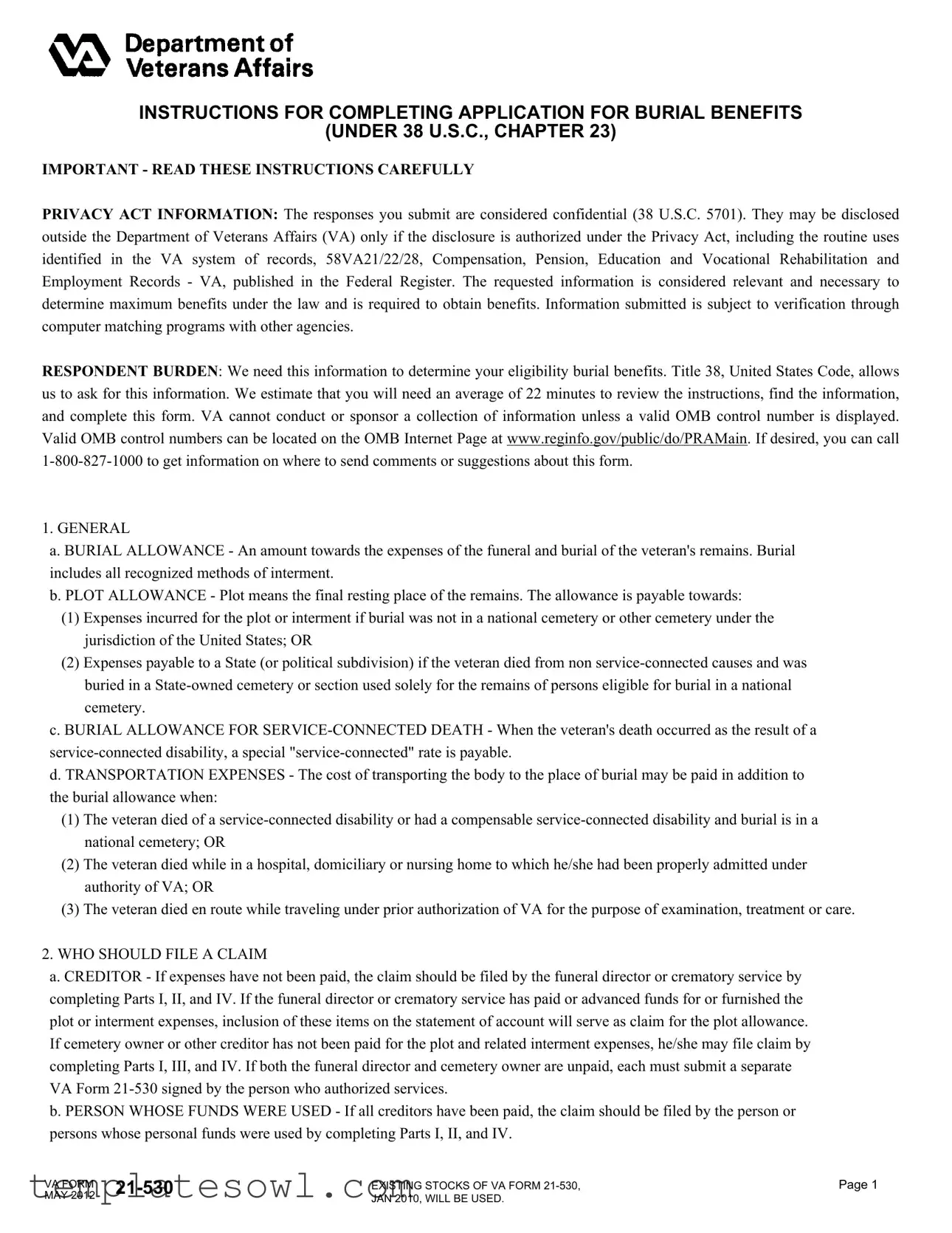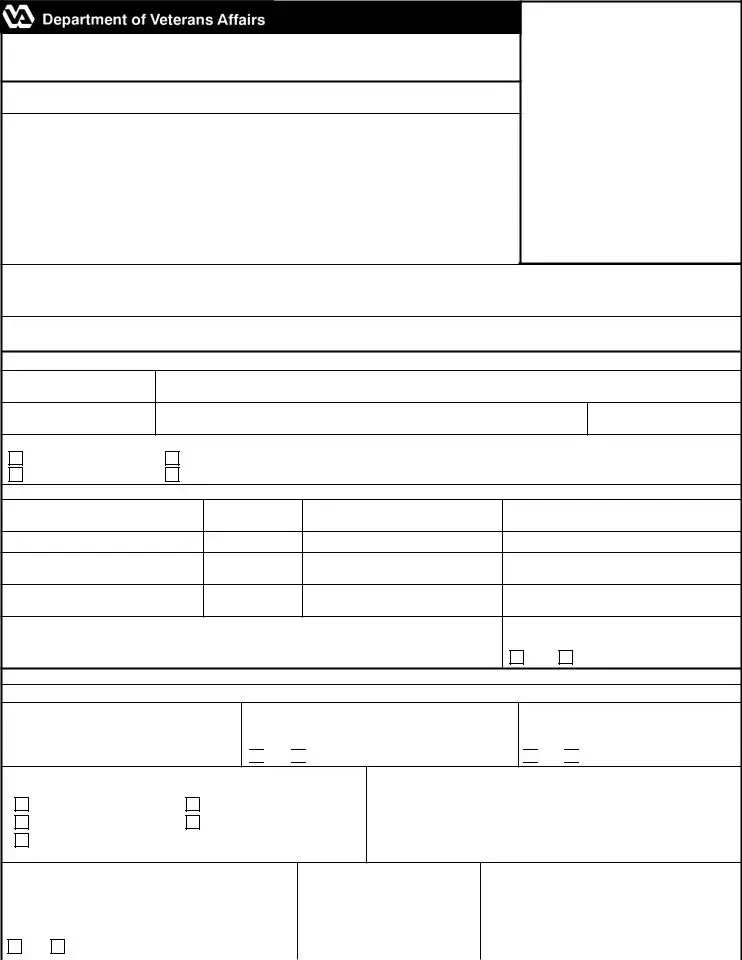INSTRUCTIONS FOR COMPLETING APPLICATION FOR BURIAL BENEFITS
(UNDER 38 U.S.C., CHAPTER 23)
IMPORTANT - READ THESE INSTRUCTIONS CAREFULLY
PRIVACY ACT INFORMATION: The responses you submit are considered confidential (38 U.S.C. 5701). They may be disclosed outside the Department of Veterans Affairs (VA) only if the disclosure is authorized under the Privacy Act, including the routine uses identified in the VA system of records, 58VA21/22/28, Compensation, Pension, Education and Vocational Rehabilitation and Employment Records - VA, published in the Federal Register. The requested information is considered relevant and necessary to determine maximum benefits under the law and is required to obtain benefits. Information submitted is subject to verification through computer matching programs with other agencies.
RESPONDENT BURDEN: We need this information to determine your eligibility burial benefits. Title 38, United States Code, allows us to ask for this information. We estimate that you will need an average of 22 minutes to review the instructions, find the information, and complete this form. VA cannot conduct or sponsor a collection of information unless a valid OMB control number is displayed. Valid OMB control numbers can be located on the OMB Internet Page at www.reginfo.gov/public/do/PRAMain. If desired, you can call 1-800-827-1000 to get information on where to send comments or suggestions about this form.
1.GENERAL
a.BURIAL ALLOWANCE - An amount towards the expenses of the funeral and burial of the veteran's remains. Burial includes all recognized methods of interment.
b.PLOT ALLOWANCE - Plot means the final resting place of the remains. The allowance is payable towards:
(1)Expenses incurred for the plot or interment if burial was not in a national cemetery or other cemetery under the jurisdiction of the United States; OR
(2)Expenses payable to a State (or political subdivision) if the veteran died from non service-connected causes and was buried in a State-owned cemetery or section used solely for the remains of persons eligible for burial in a national cemetery.
c.BURIAL ALLOWANCE FOR SERVICE-CONNECTED DEATH - When the veteran's death occurred as the result of a service-connected disability, a special "service-connected" rate is payable.
d.TRANSPORTATION EXPENSES - The cost of transporting the body to the place of burial may be paid in addition to the burial allowance when:
(1)The veteran died of a service-connected disability or had a compensable service-connected disability and burial is in a national cemetery; OR
(2)The veteran died while in a hospital, domiciliary or nursing home to which he/she had been properly admitted under authority of VA; OR
(3)The veteran died en route while traveling under prior authorization of VA for the purpose of examination, treatment or care.
2.WHO SHOULD FILE A CLAIM
a.CREDITOR - If expenses have not been paid, the claim should be filed by the funeral director or crematory service by completing Parts I, II, and IV. If the funeral director or crematory service has paid or advanced funds for or furnished the plot or interment expenses, inclusion of these items on the statement of account will serve as claim for the plot allowance. If cemetery owner or other creditor has not been paid for the plot and related interment expenses, he/she may file claim by completing Parts I, III, and IV. If both the funeral director and cemetery owner are unpaid, each must submit a separate VA Form 21-530 signed by the person who authorized services.
b.PERSON WHOSE FUNDS WERE USED - If all creditors have been paid, the claim should be filed by the person or
persons whose personal funds were used by completing Parts I, II, and IV.
VA FORM |
21-530 |
EXISTING STOCKS OF VA FORM 21-530, |
PAGE 1 |
MAY 2012 |
JAN 2010, WILL BE USED. |
|
|
|
|
c. VETERAN'S ESTATE - If the expenses were paid from the veteran's estate, the claim should be filed by the executor/ administrator by completing Parts I, II, and IV. Submit a copy of the letters of administration or letters testamentary certified over the signature and seal of the appointing court.
d. STATE - If a veteran whose death is non service-connected was buried without charge for plot or interment in a State-owned cemetery or section used for persons eligible in a national cemetery, the claim may be filed by the State official completing Parts I, III (Items 23 and 24), and IV.
3.TIME LIMIT FOR FILING A CLAIM - A claim for non service-connected burial expenses or plot allowance must be filed with VA within 2 years from the date of the veteran's permanent burial or cremation. If a veteran's discharge was corrected after death to "Under Conditions Other Than Dishonorable," the claim must be filed within 2 years from the date of correction. The
2-year limitation does not apply to service-connected burial benefits, transportation expenses or reimbursement of headstone expenses.
4.COMPLETING CLAIM BY A FIRM OR STATE AGENCY - The claim must be executed in the full name of the firm or
State agency, and show the official position or connection of the individual who signs on its behalf.
5.PROOF OF DEATH TO ACCOMPANY CLAIM - Death in a government institution does not need to be proven. In other cases, the claimant must forward a copy of the public record of death. If proof has previously been furnished VA, it need not be submitted again.
6.STATEMENT OF ACCOUNT MUST ACCOMPANY CLAIM
a.FUNERAL DIRECTOR - A statement of account on the funeral director's letterhead must show the name of the veteran; the nature and cost of services, including any payments made to another funeral home (show name and address); all credits; and the name of the person or persons by whom payment in whole or in part was made.
b.TRANSPORTATION - If transported by common carrier, a receipt must accompany the claim. All receipts for transportation charges should show the name of the veteran, the name of the person who paid and the amount of the charges. The itemized statement of account should show the charges made for transportation. Failure to itemize charges may result in delay or payment of a lesser amount.
c.ACCOUNT PAID IN FULL - The statement of account should be receipted in the name of the firm or individual performing the services. Bills or receipts filed in support of this claim become a part of the permanent record and will not be returned, unless specifically requested.
d.PLOT ALLOWANCE ONLY - In a claim for the plot allowance only, the statement of account must show the cost of the veteran's individual grave site, the mausoleum vault, or the columbarium niche.
7.BURIAL ASSOCIATION OR BURIAL INSURANCE - If the veteran was a member of a burial association or if any insurance company is obligated to pay all or part of the burial expenses, Item 22 should be answered "Yes." It will be necessary to support the claim with a statement from the association or insurance company setting forth the terms of the contract and how and with whom settlement was made.
8.SERVICE RECORD - The original or certified copy of the veteran's service separation document (DD214 or equivalent) which contains information as to the length, time, and character of service will permit prompt processing.
9.TOLL-FREE TELEPHONE ASSISTANCE - You can call us toll-free within the U.S. by dialing 1-800-827-1000. If you are located in the local dialing area of a VA regional office, you can also call us by checking your local telephone directory. For the hearing impaired, our TDD number is 1-800-829-4833.
10.WHERE DO I MAIL MY COMPLETED APPLICATION? - You should mail your application to the VA regional office located in your state. You can obtain the mailing address for VA regional offices by accessing the VA Internet web site at www.va.gov/ directory. The address is also located in the government pages of your telephone book under "United States Government, Veterans."
OMB Approved No. 2900-0003 Respondent Burden: 22 minutes
APPLICATION FOR BURIAL BENEFITS
(Under 38 U.S.C. Chapter 23)
IMPORTANT - Read instructions carefully before completing form. YOUR COMPLIANCE WITH ALL INSTRUCTIONS WILL AVOID DELAY. Type or print all information.
1. FIRST, MIDDLE, LAST NAME OF DECEASED VETERAN
2. SOCIAL SECURITY NUMBER OF VETERAN |
3. VA FILE NUMBER |
|
|
|
4. FIRST, MIDDLE, LAST NAME OF CLAIMANT |
|
|
|
5. TELEPHONE NUMBER(S) (Include Area Code) |
5C. E-MAIL ADDRESS |
|
|
|
A. DAYTIME |
B. EVENING |
|
|
|
|
(DO NOT WRITE IN THIS SPACE)
(VA DATE STAMP)
6A. MAILING ADDRESS OF CLAIMANT (Number and street or rural route, city or P.O., State and ZIP Code)
6B. IF CLAIMANT IS A FUNERAL HOME PROVIDE THE EMPLOYER IDENTIFICATION NUMBER (EIN)
PART I - INFORMATION REGARDING VETERAN
8D. WHERE DID THE VETERAN'S DEATH OCCUR? (Check one)
|
VA MEDICAL CENTER |
|
NURSING HOME UNDER VA CONTRACT |
|
|
|
|
STATE VETERANS HOME |
|
OTHER (Specify) |
SERVICE INFORMATION (The following information should be furnished for the periods of the VETERAN'S ACTIVE SERVICE)
9C. SEPARATED FROM SERVICE
9D. GRADE, RANK OR RATING,
ORGANIZATION AND BRANCH OF SERVICE
10.IF VETERAN SERVED UNDER NAME OTHER THAN THAT SHOWN IN ITEM 1, GIVE FULL NAME AND SERVICE RENDERED UNDER THAT NAME
11.ARE YOU CLAIMING THAT THE CAUSE OF DEATH WAS DUE TO SERVICE?
PART II - CLAIM FOR BURIAL BENEFITS AND/OR INTERMENT ALLOWANCE IF PAID BY CLAIMANT
NOTE - If claiming Plot Allowance Only, do not complete Part II, but complete Parts III and IV on page 4.
12. PLACE OF BURIAL OR LOCATION OF CREMAINS
15.BURIAL PLOT, MAUSOLEUM VAULT, COLUMBARIUM NICHE, ETC. COST IS: (CHECK ONE)
|
PAID BY ANOTHER PERSON(S) |
|
PAID BY CLAIMANT FOR BURIAL |
|
DUE FUNERAL DIRECTOR |
|
NONE |
|
|
|
DUE CEMETERY OWNER |
|
|
|
|
|
16.IF PLOT/INTERMENT EXPENSES ARE UNPAID, WHO WILL FILE CLAIM FOR EXPENSES? (Name and Address)
17. TOTAL EXPENSE OF BURIAL, FUNERAL, TRANSPORTATION, 18. AMOUNT PAID |
19. WHOSE FUNDS WERE USED? |
AND IF CLAIMED, BURIAL PLOT |
|
|
$ |
|
|
|
$ |
|
|
|
|
|
|
|
|
|
20A. HAS THE PERSON WHOSE FUNDS WERE USED BEEN |
20B. AMOUNT OF REIMBURSEMENT |
20C. SOURCE OF REIMBURSEMENT |
|
|
|
REIMBURSED? |
|
|
|
|
|
YES |
|
NO (If "Yes," complete Items 20B and 20C) |
$ |
|
|
|
|
|
|
|
|
|
|
|
|
|
|
|
VA FORM |
21-530 |
EXISTING STOCKS OF VA FORM 21-530, |
PAGE 3 |
|
MAY 2012 |
JAN 2010, WILL BE USED |
|
|

21A. HAS ANY AMOUNT BEEN, OR WILL ANY AMOUNT BE |
|
21B. AMOUNT |
|
|
21C. SOURCE(S) |
|
|
|
ALLOWED ON EXPENSES BY LOCAL, STATE, OR FEDERAL |
|
|
|
|
|
|
|
AGENCY? |
|
|
|
|
|
|
|
|
|
YES |
|
|
NO (If "Yes," complete Items 21B and 21C) |
|
$ |
|
|
|
|
|
|
|
|
|
|
|
|
|
|
|
|
22. WAS THE VETERAN A MEMBER OF A BURIAL ASSOCIATION OR COVERED BY BURIAL INSURANCE? |
|
|
|
|
|
|
|
|
|
|
|
|
YES |
|
|
NO (Before answering, read and comply with Instruction 7 on Page 2) |
|
|
|
|
|
|
|
|
|
|
|
|
|
|
|
|
|
|
|
|
|
|
|
|
|
|
|
|
|
|
PART III - CLAIM FOR PLOT COST ALLOWANCE |
|
IMPORTANT - Complete only if burial was NOT in a national cemetery or cemetery owned by the Federal Government. |
|
|
|
|
|
|
|
|
|
|
|
|
23. WAS BURIAL (WITHOUT CHARGE FOR PLOT OR INTERMENT) IN |
24. PLACE OF BURIAL OR LOCATION OF CREMAINS |
|
A STATE OWNED CEMETERY, OR SECTION THEREOF, USED SOLELY FOR |
|
|
|
|
|
PERSONS ELIGIBLE FOR BURIAL IN A NATIONAL CEMETERY? |
|
|
|
|
|
|
|
|
|
|
|
|
|
|
|
|
YES |
|
|
NO |
|
|
|
|
|
|
|
|
|
|
|
|
|
|
|
|
|
|
|
|
|
|
|
|
|
|
|
|
|
25A. COST OF BURIAL PLOT (Individual Grave Site, Mausoleum Vault, or |
25B. DATE OF PURCHASE |
25C. DATE OF PAYMENT |
|
|
Columbarium Niche) |
|
|
|
|
|
|
$ |
|
|
|
|
|
|
|
|
|
|
|
|
|
|
|
|
|
|
|
|
|
26A. HAVE BILLS BEEN PAID IN FULL? |
26B. AMOUNT PAID |
|
27. WHOSE FUNDS WERE USED? |
|
|
|
|
|
|
|
|
|
|
|
|
YES |
|
|
NO (If "No," complete Items 26B and 27) |
$ |
|
|
|
|
|
|
|
|
|
|
|
|
|
|
|
|
|
28A. HAS PERSON WHOSE FUNDS WERE USED BEEN |
28B. AMOUNT OF REIMBURSEMENT |
28C. SOURCE OF REIMBURSEMENT |
|
|
REIMBURSED? |
|
|
|
|
|
|
|
|
|
|
$ |
|
|
|
|
|
|
|
YES |
|
|
NO (If "Yes,"complete Items 28B and 28C) |
|
|
|
|
|
|
|
|
|
|
|
|
|
|
|
|
|
29A. HAS ANY AMOUNT BEEN, OR WILL ANY AMOUNT |
29B. AMOUNT |
|
29C. SOURCE |
|
|
|
BE ALLOWED ON EXPENSES BY STATE OR FEDERAL |
|
|
|
|
|
|
|
|
AGENCY? |
|
|
|
|
|
|
|
|
|
YES |
|
|
NO (If "Yes,"complete Items 29B and 29C) |
$ |
|
|
|
|
|
|
|
|
|
|
|
|
|
|
|
|
|
|
|
|
|
|
|
|
|
|
|
|
|
|
|
|
|
|
PART IV - CERTIFICATION AND SIGNATURE |
|
I CERTIFY THAT the foregoing statements made in connection with this application on account of the named veteran are true and correct to the best of my knowledge and belief.
30A. SIGNATURE OF CLAIMANT (If signed using an "X", complete Items 36A thru 37B) |
30B. OFFICIAL POSITION OF PERSON SIGNING ON BEHALF OF FIRM, |
(If signing for firm, corporation, or State agency, complete Items 30B thru 31) |
CORPORATION OR STATE AGENCY |
|
|
31. FULL NAME AND ADDRESS OF THE FIRM, CORPORATION, OR STATE AGENCY FILING AS CLAIMANT |
NOTE - Where the claimant is a firm or other unpaid creditor, Items 32A thru 35 MUST be completed by the individual who authorized services.
I CERTIFY THAT the foregoing statements made by the claimant are correct to the best of my knowledge and belief.
32A. SIGNATURE OF PERSON WHO AUTHORIZED SERVICES (If signed using an "X", |
32B. NAME OF PERSON AUTHORIZING SERVICES (Type or Print) |
complete Items 36A thru 37B) |
|
|
|
33. ADDRESS (Number and street or rural route, city or P.O., State and ZIP Code) |
|
34. DATE |
35. RELATIONSHIP TO VETERAN |
|
|
WITNESS TO SIGNATURE IF MADE BY "X"
NOTE - If claimant signed above using an "X", signature must be witnessed by two persons to whom the person making the statement is personally known, and the signatures and addresses of such witnesses must be shown below.
36A. SIGNATURE OF WITNESS |
36B. ADDRESS OF WITNESS |
|
|
37A. SIGNATURE OF WITNESS |
37B. ADDRESS OF WITNESS |
|
|
PENALTY - The law provides severe penalties which include fine or imprisonment, or both, for the willful submission of any statement or evidence of a material fact knowing it to be false.
DEPARTMENT OF VETERANS AFFAIRS HEADSTONES AND MARKERS
The Department of Veterans Affairs will furnish, upon request, a Government headstone or marker at the expense of the United States for the unmarked graves of certain individuals eligible for burial in a national cemetery, but not buried there. These individuals include any veteran with an other than dishonorable discharge who dies after service or any serviceman or servicewoman who dies on active duty. Certain other individuals may also be eligible for the headstone or marker. Headstones or markers for all individuals in a national or post cemetery are furnished automatically without request from the family.
For additional information on burial benefits go to the web site, www.cem.va.gov/bbene_burial.asp. To obtain VA Form 40-1330, Application for Standard Government Headstone or Marker go to www.va.gov/vaforms or contact your local VA regional office. The address of that office can be found at to www.va. gov/directory.
VA FORM 21-530, MAY 2012 |
PAGE 4 |
|











